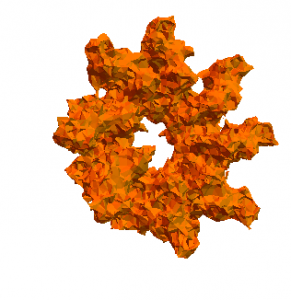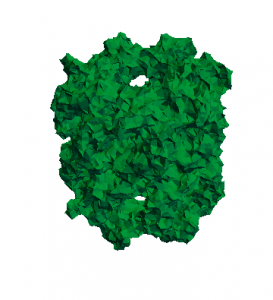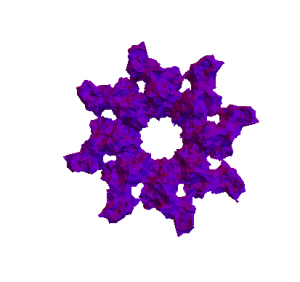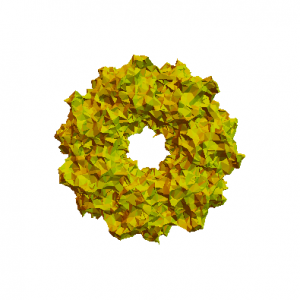Inspiration
At the scale of a few nanometers, chemical interactions (from covalent bonds to hydrogen bonds and van der Waals interactions) collectively give rise to material phenomena, such as viscosity, elasticity, and phase separation, in many condensed phase systems. Biological cells, for instance, likely exploit delicate balances of these interactions to regulate signalling, endocytosis, replication, and many other processes, although precise characterization of the nanoscale structures that are involved can be extremely challenging. Mass spectrometry, ion mobility spectrometry, and allied techniques have proved invaluable for studying the structure and organization of many kinds of matter, from simple molecules to megadalton-sized cytosolic and membrane protein assemblies. Using methods capable of transferring and analyzing intact macromolecular assemblies in the gas phase while retaining much of their condensed-phase tertiary and quaternary structure, our lab learns complementary information about their shape and folding state in these same experiments using ion mobility measurements. Combined with computational modeling and results from other bioanalytical experiments, data obtained with these methods can be used to construct detailed models of these assemblies. Studying the relationship between these structures and the condensed-phase environment in which they arise enables us to paint a vivid picture of how biology bridges the gap from chemical to material properties, with a view toward biochemical and pharmaceutical applications.
Technology and Innovation
The Prell Group has a Synapt G2-Si mass spectrometer equipped with an M-class UPLC, both from Waters Corporation, and an Agilent 6545XT QTOF mass spectrometer equipped with an Agilent 1290 Infinity II LC. Both “static” nanoelectrospray and UPLC-interfaced ion sources are used. The Synapt instrument can achieve a resolving power > 50,000 and is fitted with a high-mass quadrupole capable of isolating ions with m/z up to 32,000, and the Agilent instrument has a maximum resolving power of > 45,000 and mass range up to m/z 10,000. The Synapt instrument can perform ion mobility measurements and ion separations in addition to electron transfer dissociation, making it a highly versatile tool for studying biomolecular complexes, which often comprise many different sizes and types of biomolecules. Surface-induced dissociation (SID) capabilities (generously provided by Waters Corp. and the Wysocki group at The Ohio State University) are also available to access fragmentation pathways not available with collision-induced dissociation (CID). Electron capture dissociation (ECD) capabilities for the Synapt instrument are available through the generous loan of online ECD devices designed and fabricated by e-MSion, Inc.
Our group also develops analytical tools (in particular, iFAMS) for interpreting highly congested mass spectra that arise in studying biomolecular assemblies (including membrane protein-lipid assemblies), bioconjugates, and copolymers. These tools mitigate problems caused by overlap of analyte signal with salt cluster and other nuisance background signals and provide easy access to charge-state, subunit mass, and both charge-state-specific and total mass distributions. Phase-based Macromolecular Mass Defect Analysis is also implemented. We have also developed an open-source package (Collidoscope) for predicting collision cross sections in ion mobility spectrometry via the “Trajectory Method”, available for Linux, Windows, and Mac operating systems. In development is a software suite called “IonSPA” (SPA= Simulations of the Physics of Activation), which can be used to model collisional heating and cooling of ions in a time- and space-resolved fashion in various types of mass spectrometer ion guides, sources, and activation regions.
Beyond and in conjunction with using commercially available technology, our group also approaches challenging problems in studying nanoscale assemblies by designing, building, and using our own instrumentation.
Computational Modeling
Computational models can be extremely useful to predicting and interpreting experimental results, from the appearance of a complicated mass spectrum to the bonds that hold molecules together. Projects in our group incorporate statistical mechanics, molecular dynamics, and quantum mechanical simulations as well as ion trajectory modeling. We have written a program (Collidoscope, available for download on Github at https://github.com/prellgroup/Collidoscope) to calculate collision cross sections of very large (up to a few MDa) molecules and assemblies that implements a classical “Trajectory Method” based on non-equilibrium statistical mechanics. Published protocols from our group describe how Collidoscope can be combined with simple Molecular Dynamics simulations to improve accuracy and precision of cross section predictions. We have also developed software to facilitate analysis of congested electrospray mass spectra for ions with repeated subunits (iFAMS, available for download on Github at https://github.com/seanpatcleary/ifams), and ion collisional heating and cooling (IonSPA, coming soon).
Research Support
Current support comes from the National Science Foundation (CAREER Award), two University Relations gifts from Agilent Technologies, the National Institute of General Medical Sciences, and the National Eye Institute. Previous support for our research came through the generosity of the National Institute of Allergy and Infectious Diseases, an American Society for Mass Spectrometry Research Award, and a collaborative seed grant sponsored by the University of Oregon and Oregon Health and Science University.
Joining Our Team
Interested undergraduates should email Jim Prell (jprell-at–uoregon–dot–edu). Students interested in joining the Prell Lab through our PhD program, in which first-year students typically rotate through three research labs, should apply via the Department’s application website (https://chemistry.uoregon.edu/graduate/apply/) and note their interest in the Prell Lab in their application.



